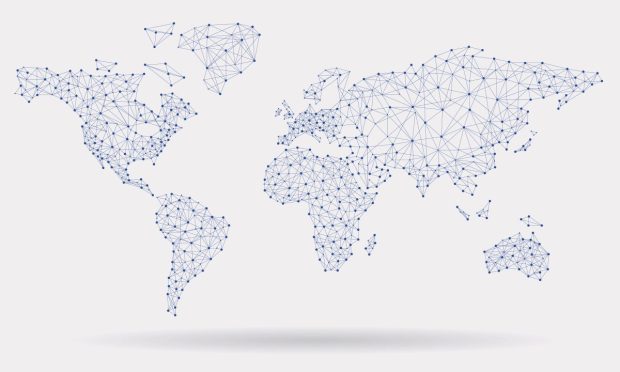‘Google Maps for Business’ Aims to Minimize Supply Chain Risk

In the age of global commerce, gauging supply chain risk is the business world’s version of playing “six degrees of Kevin Bacon.”
If it’s a truism that all people in Hollywood are only a few film credits away from the Footloose star, it’s not a stretch to say that all companies — buyers and suppliers — are linked as well, in one way or another, no matter where they are or what they do.
The challenge for companies is to understand where risks lie, especially across borders.
“A lot of things that are breaking down in the world are at the network level, not at the buyer-supplier relationship level,” Altana Technologies CEO Evan Smith told Karen Webster.
It’s that sixth or seventh degree of separation that winds up causing the seismic shift, and it’s located and lurking somewhere upstream in the supply chain.
Well beyond the challenges of COVID, enterprises, logistic providers and governments also must monitor the changing risks and disruptions — environmental and geopolitical — that can bring trade to a standstill or even make sourcing goods difficult in the first place. Regulations and import bans are fluid.
But as Smith said, “everything’s been obscured by this interconnected but opaque fog. What we’re trying to do is first clear away that fog.” Visibility can be vastly improved, he said, by using a network approach to forge a single, unified view of supply chain risk.
AI, machine learning and federated knowledge graphs can create a network that illuminates broad-based, real-time information about global supply chains, said Smith. That shared data is helping users of Altana’s Atlas platform make better decisions about their extended supply chains — gauging not just the risk inherent in direct supplier relationships, but also the threats that lie continents away.
“Globalization 2.0 is going to be defined by these trusted networks,” he said.
Google Maps – For Business Networks
Altana traces its genesis back to 2018, but Smith’s fascination with earth-scale physical systems predates the firm’s founding, and he spent years in the renewal energy sector and at a company that was focused on automating the textile supply chain.
“I’ve come to appreciate the fact that the whole world’s a supply chain,” he said. “It’s not a niche thing…it’s the most interesting thing.”
In founding Altana as a subscription-based data provider, he said, the most compelling opportunity has been in connecting data that “stitches in” customer data to forge maps.
Having spent millions of dollars on commercial data and cloud tech to build the seeds of Atlas, the platform now unifies billions of records in several languages, with non-commercial information collected on 420 million entities and analyzed at scale.
One analog for Atlas: think Google Maps, but for business networks, as enterprises seek to ensure business continuity and hone their strategy.
To be sure, there are other supply chain risk technologies and solutions out there — and comprehensive mapping databases, too — but Smith says there are few with the canonical map of the business world, at scale, where networks are visually connected to an intricate series of other networks.
In the background, he said, Altana’s investigative users help to scour the globe for risk. That risk can include uncovering everything, from Western technology finding its way into Russian weapons systems, to Uyghurs toiling in forced labor in China, making the pants and jeans and blouses that are everywhere around the globe.
“They’re also looking at entire supply chains,” he said, “and examining where there are vulnerabilities due to business interruption or nation-state threats.”
Those granular levels of insight can help break down data silos as Altana’s client firms discover — through several degrees of separation — whether suppliers are doing business in ways inconsistent with the client’s values. And when anomalies are uncovered, the platform can suggest an alternative to Atlas’ users, who typically are COO or procurement officers (and sustainability officers, too).
Smith explained that through the company’s federated learning platform, the Altana Atlas constantly learns from the billions of data points gleaned from public and non-public data. He stressed that “we take a copy of that data and bring it down to a ‘spoke’ that is customer-specific. We bring the map to you, not the other way around.”
Intelligence is shared across the network and between all users, but not the data itself. Each enterprise effectively has its own proverbial thumbprint of the data to be used within the confines and privacy of their own organizations, but that information never leaves the “spoke” that’s been created.
The Next Level of Supply Chain Efficiency
Atlas’ supply chain analytics can “run” product families through hypothetical supply chains winding through new countries –—and coordinate various supply and demand scenarios across multiple tiers of supply chains. Buyers, after all, have learned through the past few years that they must have a range of suppliers on hand and pivot as needed when national security concerns arise or natural disaster strikes.
Altana announced earlier this month that it raised $100 million in a Series B funding round, and down the road there lies the opportunity to layer other functions on top of the platform, including finance and insurance.
“The big unsolved problem that I’m really excited about is purchase order financing. Nobody’s cracked that. And I think we can do some very novel things there,” he told Webster.
For now, said Smith, “we’re trying to bring everybody into a shared source of truth where we collaborate with each other, connect and then do business — across the climate and national security and trade compliance dimensions that require this network coordination.”
